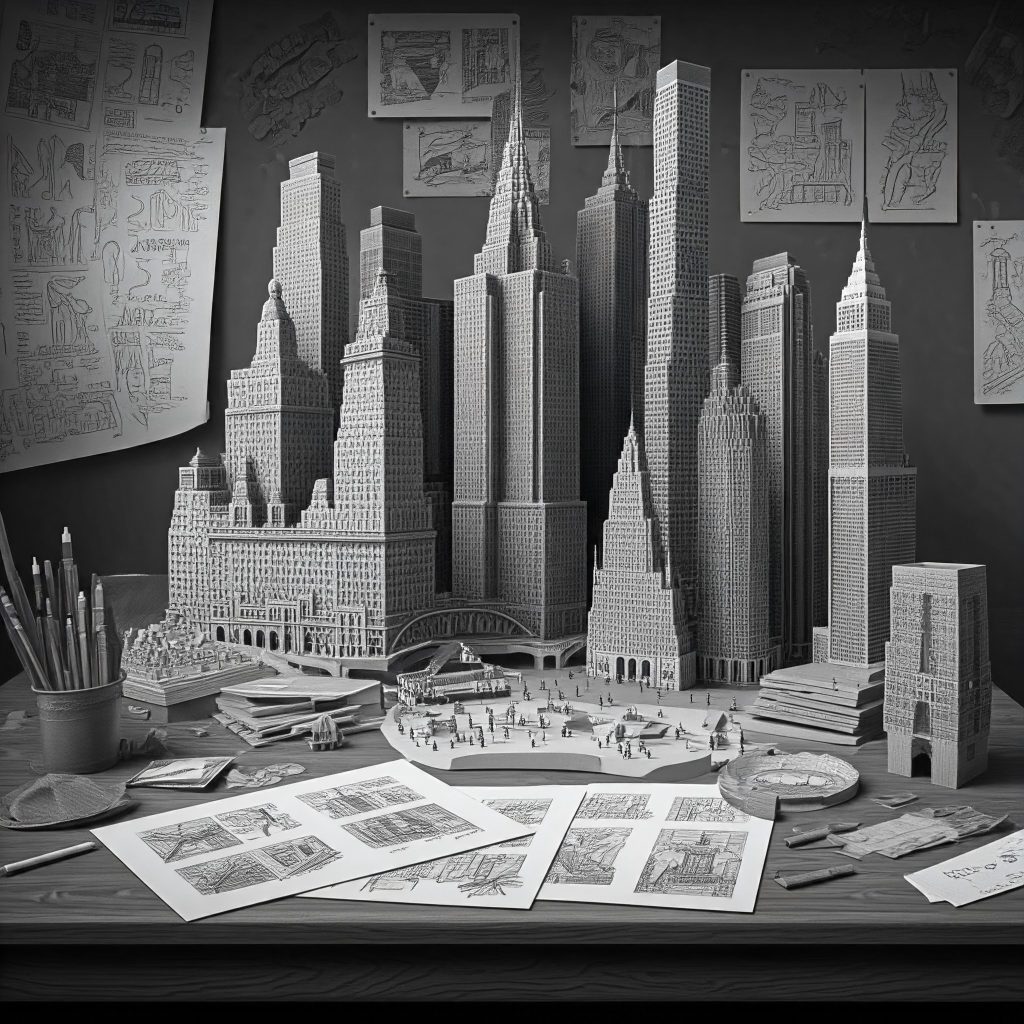Koolhaas and the Culture of Congestion
The neon hum of Times Square blurred into a dreamlike haze as Will Hunter tightened his grip on Rem Koolhaas’s Delirious New York. The book had been his companion since his first urban design course at Iowa State University. Now, standing amidst New York City’s vibrant chaos, Will felt an inexplicable pull toward the city Koolhaas had immortalized—a city that thrived on contradictions and celebrated congestion.
.
Koolhaas’s manifesto framed Manhattan as a place where density birthed creativity, and absurdity transformed into genius. To Will, the pages were both a map and a riddle, urging him to see the city’s design as a fantastical machine. But something about Times Square that night felt off—as if the city were alive, watching.
.
The first crack in reality came when a giant billboard flickered and displayed an image of the Empire State Building with a cryptic phrase: “Find the soul of the skyscraper.” Will blinked, but the words disappeared, leaving him shaken. “It’s just the city playing tricks,” he muttered. Still, a strange curiosity tugged at him.
The Empire State’s Secrets
Determined to shake the unease, Will headed for the Empire State Building, Koolhaas’s “propaganda tool for the city.” The structure loomed above him like a sentinel, its art-deco lines cutting through the night sky.
.
Riding the elevator to the observation deck, Will couldn’t shake the feeling that the building was more than steel and stone. Koolhaas had described it as a myth, a vertical narrative of ambition. Now, the city spread out before him, its grid glowing like veins of light. As Will marveled at the view, he noticed a peculiar pattern in the streets below—an inexplicable symmetry that seemed deliberate.
.
Suddenly, a man in a trench coat appeared beside him. “Beautiful, isn’t it?” the man said, his voice low. “Koolhaas understood the Empire State Building was more than an icon—it was a compass for the city’s hidden geometry.”
.
Will’s pulse quickened. “Who are you?”
“A guide,” the man said cryptically. “You’ll need to follow the lines to understand Koolhaas’s vision.” Before Will could respond, the man vanished into the crowd, leaving behind a map marked with strange symbols.
Coney Island: The Laboratory of Fantasy
The map led Will to Coney Island, where Koolhaas had found the origins of New York’s surrealism. The boardwalk buzzed with a peculiar energy, though the usual carnival atmosphere was absent. Instead, the rides stood still, their mechanical forms casting eerie shadows.
.
Koolhaas had once called Coney Island a “laboratory of urban experimentation.” Here, architects and dreamers tested the boundaries of technology and imagination. As Will wandered through the park, he felt a shift in the air. The Ferris wheel groaned to life, and an old speaker crackled, playing distorted carnival music.
.
An aged notebook lay on a nearby bench. Its cover bore the title The Culture of Congestion. Inside, Will found sketches of fantastical buildings and cryptic notes about merging fantasy with functionality. A single sentence stood out: “The city’s delirium is its greatest strength.”
The Waldorf Astoria’s Transformation
The map’s next clue led Will to the Waldorf Astoria, Koolhaas’s example of architectural alchemy. Entering the grand lobby, Will felt the weight of history. The hotel had been designed as a vertical city—a microcosm of urban life within its walls.
.
A staff member approached him with a sealed envelope. Inside was a single sentence: “The Waldorf was the prototype; the city is the experiment.”
.
Exploring the hotel, Will uncovered secret passageways and forgotten blueprints. They revealed an audacious plan: to recreate the hotel’s concept on a citywide scale, blending luxury with accessibility. Koolhaas’s vision wasn’t just theoretical—it was a blueprint for the future.
The Dream Ends, Lessons Remain
Will awoke with a start, his heart racing. The symbols, the eerie encounters, and the whispered lessons still echoed in his mind. Had it all been a dream, or had Koolhaas’s vision truly come alive to guide him?
.
He opened Delirious New York again, now with fresh eyes. Koolhaas’s genius wasn’t just in celebrating Manhattan’s contradictions—it was in revealing how design could turn chaos into order, and absurdity into purpose.
.
As he sat on the steps of the New York Public Library, the city’s narrative unfolded before him like a living organism. Will jotted down five key lessons he’d gleaned from his dreamlike journey.
Learning Points
- Congestion Fuels Creativity: Dense, chaotic spaces can spark innovation and ingenuity.
- Fantasy Enhances Functionality: Imagination is vital in designing spaces that inspire and delight.
- Design Is a Narrative: Architecture tells stories that shape cultural identity.
- Absurdity Is a Strength: Embracing contradictions can lead to breakthroughs in urban planning.
- Cities Are Experiments: Each building, street, and neighborhood contributes to an evolving urban laboratory.
Keywords:
- Koolhaas
- Delirious New York
- Manhattan urban design
- Culture of congestion
- Coney Island architecture
- Waldorf Astoria transformation
- Rem Koolhaas’s theories
- Skyscraper narratives
- New York Public Library design
- Urban experimentation
This fictional story is set within the dreams of Will Hunter, a character created to explore the intersection of imagination and design. Dive into his dreamscape and discover how storytelling can illuminate real-world lessons in architecture and creativity.
Some of the links on this website may be affiliate links. This means that if you click on the link and make a purchase, we may receive a small commission. We only recommend products and services that we genuinely believe will be beneficial to our readers.




